The art, or the expressions of the human experiences in the Philippines mirror a general public with assorted social impacts and conventions. The Malayan people groups had early contact with merchants who presented Chinese and Indian impacts. Islamic conventions were first acquainted with the Malays of the southern Philippine Islands in the fourteenth century. Most current parts of Philippine social life advanced under the unfamiliar standard of Spain and, later, the United States. In the sixteenth century the Spanish forced an unfamiliar culture situated in Catholicism. While the marsh people groups were assimilated through strict transformation, the Muslims and some upland ancestral gatherings kept up social freedom. Among the individuals who were absorbed emerged an informed tip top who started to set up a cutting edge Filipino artistic custom. During the primary portion of the twentieth century, American impact made the Philippines one of the most Westernized countries in Southeast Asia. The social developments of Europe and the United States significantly affected Filipino specialists, much after autonomy in 1946. While drawing on Western structures, in any case, crafted by Filipino painters, essayists, and performers are instilled with particularly Philippine topics. By communicating the social extravagance of the archipelago in the entirety of its decent variety, Filipino specialists have assisted with molding a feeling of national character. Numerous Malay social customs have made due regardless of hundreds of years of unfamiliar standard. Muslims and upland ancestral gatherings keep up unmistakable conventions in music, dance, and sculpture. What’s more, numerous Filipino artist fuse indigenous society themes into current structures. The visual arts are art forms such as painting, drawing, printmaking, sculpture, ceramics, photography, video, filmmaking, design, crafts, and architecture. Many artistic disciplines such as performing arts, conceptual art, textile arts also involve aspects of visual arts as well as arts of other types.
Visual arts in Pre-Spanish Colonial Period
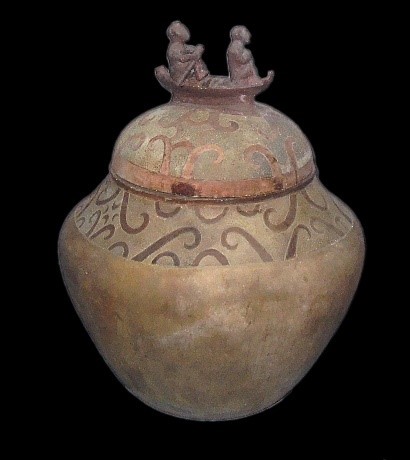
Manunggul Jar from Palawan (890–710 BC)
Early Filipino painting can be found in red slip (clay mixed with water) designs embellished on the ritual pottery of the Philippines such as the acclaimed Manunggul Jar.
The Manunggul Jar is a secondary burial jar excavated from a Neolithic burial site in Manunggul cave of Tabon Caves at Lipuun Point at Palawan dating from 890–710 B.C
Painting are also manifested in the tattoo tradition of early Filipinos, whom the Portuguese explorer referred to as Pintados or the ‘Painted People’ of the Visayas.
Early Filipino’s painting can be manifested today among the arts and architecture of the Maranao who are well known for the Nāga Dragons and the Sarimanok carved and painted in the beautiful Panolong of their Torogan or King’s House.
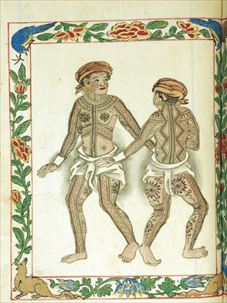
Visayan pintados
Visual arts in Spanish Colonial Period
Artistic paintings were introduced to the Filipinos in the 16th century when the Spaniards arrived in the Philippines. Spaniards used paintings as religious propaganda to spread Catholicism throughout the Philippines. Paintings appeared mostly on church walls, featured religious figures appearing in Catholic teachings. Filipinos began creating paintings in the European tradition during the 17th- century Spanish period. Most of the paintings and sculptures between the 19th, and 20th century produced a mixture of religious, political, and landscape art works, with qualities of sweetness, dark, and light.
Visual arts in Post-Spanish Colonial Period (Modern)
Early modernist painters such as Damián Domingo was associated with religious and secular paintings. The art of Juan Luna and Félix Hidalgo showed a trend for political statement. Artist such as Fernando Amorsolo used post- modernism to produce paintings that illustrated Philippine culture, nature, and harmony.
Sculpture
Sculpture is the branch of the visual arts that operates in three dimensions. It is one of the plastic arts. Durable sculptural processes originally used carving (the removal of material) and modelling (the addition of material, as clay), in stone, metal, ceramics, wood and other materials but, since Modernism, there has been an almost complete freedom of materials and process. A wide variety of materials may be worked by removal such as carving, assembled by welding or modelling, or moulded or cast.
Philippine Sculpture is the most familiar art forms among Filipinos. From the transitional carving of anitos to the santos to Christ and down to the saints, Filipinos find it rather not difficult as they are already familiar with.
Indigenous woodcarving is one of the most notable traditional arts in the Philippines, with some crafts in various ethnic groups date back prior to Hispanic arrival with perhaps the oldest surviving today are fragments of a wooden boat dating to 320 AD.[50] Many societies utilize a variety of woods into making wood crafts such as sacred bulul figures. These divine wooden statues, known in various groups through different generic names, abound throughout the Philippines from the northern Luzon to southern Mindanao. The art of okir on wood is another fine craft attributed to various ethnic groups in Mindanao and the Sulu archipelago. Wood crafts of specific objects, such as sword hilts, musical instruments, and other objects are also notable, where depictions of ancient mythical beings are usually carved. There are other indigenous wood crafts and techniques in the Philippines, some of which have been utilized in Hispanic woodcarvings after colonization, such as the woodcarving styles of Paete.
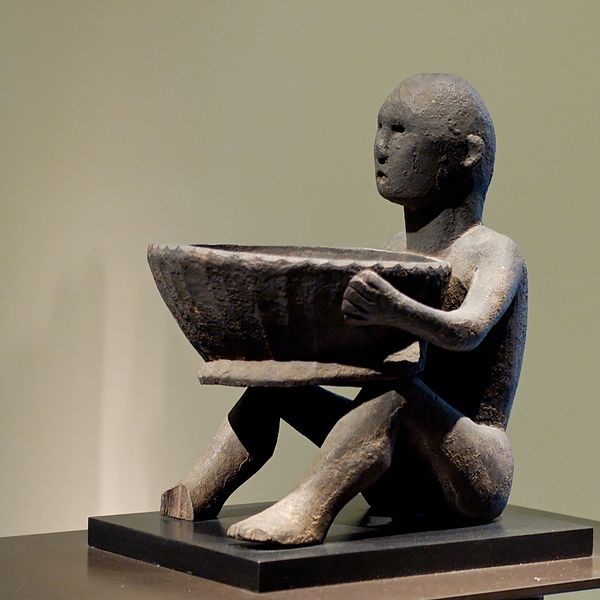
Bulul god with pamahan cup (15th century)
Religious Hispanic woodcarvings abounded in the Philippines with the introduction of Christianity. The techniques utilized infuse both indigenous and Hispanic styles, creating a fusion of Hispanic-Asian wood art. Paete, Laguna is among the most famous woodcarving places in the country, especially on religious Hispanic woodcarving. Various epicenters of woodcarving in the Hispanic tradition are also present in many municipalities, where majority of the crafts are attributed to the life of Christ and the Virgin Mary, where Marian traditions prevail.

Bas relief at Panay Church (1770’s)
Stone carving is a priced art form in the Philippines, even prior to the arrival of Western colonizers, as seen in the stone likha and larauan or tao-tao crafts of the natives. These items usually represents either an ancestor or a deity who aids the spirit of a loved one to go into the afterlife properly. Ancient carved burial urns have been found in many areas, notably in the Cotabato region. The Limestone tombs of Kamhantik are elaborate tombs in Quezon province, believed to initially possess rock covers signifying that they were sarcophagi. These tombs are believed to have been originally roofed, as evidenced by holes marked onto them, where beams have been placed. Stone grave marks are also notable, with the people of Tawi-Tawi, and other groups using the carved marks with okir motif to aid the dead. In many areas, sides of mountains are carved to form burial caves, especially in the highlands of northern Luzon. The Kabayan Mummy Burial Caves is a prime example. Marble carvings are also famous, especially in its epicenter in Romblon. Majority of the marble crafts are currently meant for export, mostly Buddhist statues and related works.With the arrival of Christianity, Christian stone carvings became widespread. Most of which were either parts of a church such as facades or interior statues, or statues and other crafts intended for personal altars. A notable stone carving on a church is the facade of Miagao Church.
Ivory carving is an art practiced in the Philippines for more than a thousand years, with the oldest known ivory artifact known is the Butuan Ivory Seal, dated 9th–12th century. The religious carvings of ivory, or garing as locally known, became widespread after the direct importation of ivory into the Philippines from mainland Asia, where carvings focused on Christian icons, such as Madonna with Child, the Christ Child, and the Sorrowful Mother. Many of the ivory carvings from the Philippines have gold and silver designs. The ivory trade in the Philippines boomed because of the demand for ivory carvings, and continued up to the 21st century. In recent years, the Philippine government has been cracking down on the illegal ivory trade. In 2013, the Philippines became the first country in the world to destroy its ivory stock, to show solidarity among like-minded nations against the ivory trade which has decimated the world’s elephant and rhino populations. Horns of dead carabaos have been used as a substitute to ivory in the Philippines for centuries.
Architecture
Architecture is an artistic expression that reflects how we present ourselves over the world’s scene, and, as other expressive mediums, it changes with styles, advancements and social transformations.
The architecture of the Philippines reflects the historical and cultural traditions in the country. Most prominent historic structures in the archipelago are influenced by Austronesian, Chinese, Spanish, and American architectures.
For 2,000 years the mountainous province of Ifugao have been carefully cultivated with terraced fields. The structures’ original builders used stone and mud walls to carefully carve and construct terraces that could hold flooded pond fields for the cultivation of rice. They also established a system to water these plots by harvesting water from mountaintop forests. These engineering feats were done by hand as was the farming itself.
Maintenance of the rice terraces reflects a primarily cooperative approach of the whole community. Invention of various tools allowed for the fabrication of tent-like shelters and tree houses. Early Classical houses were characterized by rectangular structures elevated on stilt foundations and covered by voluminous thatched roofs ornamented with gable- finials and its structure could be lifted as a whole and carried to a new site.
The Bahay Kubo is the Filipino word for Nipa huts, they were the native houses of the indigenous people of the Philippines before the Spaniards arrived. They are still used today, especially in rural areas. Different architectural designs are present among the different ethnolinguistic groups in the country.
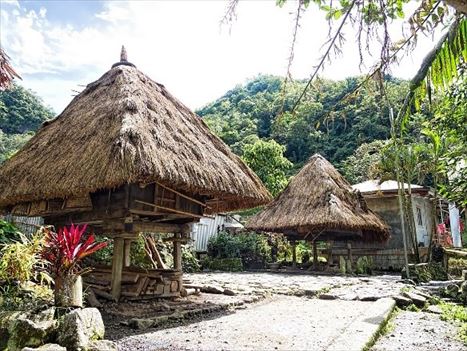
With the arrival of Indianized and Muslim scholars from nearby Indonesia, the native Filipinos were introduced to the concept of the Kota or fort. The Muslim Filipinos of the south built strong fortresses called kota or moong to protect their communities. These kotas were usually made of stone and bamboo or other light materials and surrounded by trench networks. Many of these forts were also destroyed by American expeditions, as a result, very very few kotas still stand to this day.
The existing torogans were built by the community and the slaves for the King in 1800s. The windows of torogan are slits and richly framed in wood panels with okir designs located in front of the house. The distinct high gable roof of the torogan, thin at the apex and gracefully flaring out to the eaves, sits on a structure enclosed by slabs of timber and lifted more than two meters above the ground by a huge trunk of a tree that was set on a rock. The house was built to sway during earthquakes. Twenty-five post of huge tree trunks were not buried but are freestanding.
With the arrival of Islam in Mindanao, Mosques, the masjid was extensively built, like the Sheik Karimal Makdum Mosque in Simunul, Tawi-Tawi, which was built in 1380. During the establishment of the Sultanate of Sulu, a wooden palace was built for the Sultans which had the name Astana Darul Jambangan which has been destroyed by a typhoon in 1912. A replica of the royal palace was rebuilt as an attraction in Mt. Bayug Eco-Cultural Park in the town of Talipao, Sulu.
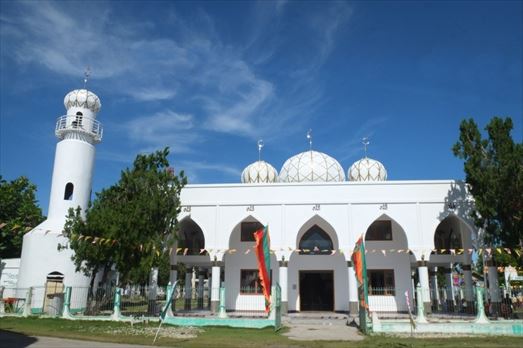
Sheik Karimol Makhdum Mosque
The arrival of the Spaniards in 1571 brought in European colonial architecture to the Philippines. Since the Spaniards brought Christianity to the islands, they created the need to establish religious structures to support the growing number of religious organizations. Some of the best-preserved colonial churches in the country are found in the Ilocos Region, as well as those in the provinces of Laguna, Batangas, Cebu and Bohol.
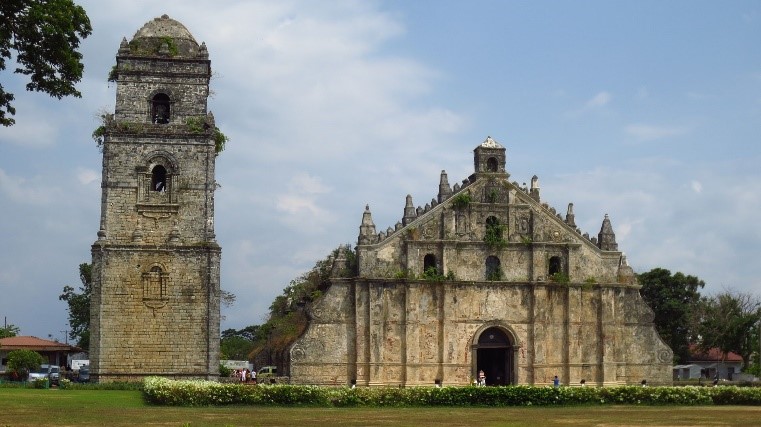
St. Agustin church, Paoay, Ilocos Norte
The Bahay na bato, the colonial Filipino house, followed the nipa hut’s arrangements such as open ventilation and elevated apartments. The bahay na bato was constructed out of brick and stone rather than the traditional bamboo materials. It is a mixture of native Filipino, Spanish and Chinese influences. During the 19th century, wealthy Filipinos built some fine houses, usually with solid stone foundations or brick lower walls, and overhanging, wooden upper story with balustrades and capiz shell sliding windows, and a tiled roof.
The historic city was home to centuries-old churches, schools, convents, government buildings and residences, the best collection of Spanish colonial architecture before much of it was destroyed by the bombs of World War II. Of all the buildings within the 67- acre city, only one building, the San Agustin Church, survived the war.
With the arrival of the Americans in 1898 came a new breed of architectural structures in the Philippines. Foremost of the American contributions to the country was the establishment of civil government. This led to the erection of government buildings from the city all the way to the municipal level.
The modern era dawned on Philippine architecture using the simple straight lines of the International Modern Style as a chief mode of expression. By the 1970s, a new form of Philippine architecture emerged with the filipinization of architecture. By the 1980s the country’s architectural idiom was swept by the tide of Post Modernism, a hearkening back of some sort to classical architecture. Today, architecture in the Philippines continue to be vibrant and with the country opening up to the world, more first rate architecture is pouring in.
The Cultural Center of the Philippines Complex is home to the National Theater (Tanghalang Pambansa). The theater is the centerpiece of the 77 hectare (190 acres) arts and culture complex located along Roxas Boulevard in Manila. Designed by Leandro V. Locsin, the construction of the National Theater began in 1966 and was completed in 1969. The theater is a primary example of the architect’s signature style known as the floating volume, a trait can be seen in structures indigenous to the Philippines such as the nipa hut. It houses three performing arts venues, one theater for film screenings, galleries, a museum and the center’s library and archives.

Philippine Arena
The Philippine Arena is a multi- purpose indoor arena being constructed at Ciudad de Victoria, a 75-hectare tourism enterprise zone in Bocaue and Santa Maria, Bulacan, Philippines. With a capacity of up to 55,000, it is the world’s largest indoor arena once completed.
The visual arts in the Philippines envelop a scope of structures created by Filipinos in the Ethnic, Spanish, American, and contemporary customs. In ethnic communities, pottery, weaving, carving, and metalcraft are made for ceremonial purposes or for ordinary use. Spanish colonization presented painting and model whose topic was generally strict, albeit mainstream subjects and structures developed in the nineteenth century under the support of the new mestizo first class. The American time frame saw the contention among conservatism and innovation, with the last making progress at long last in painting and figure. After World War II specialists investigated an assortment of Western and Eastern styles, media, and methods of reasoning—some conciously returning to ethnic roots—to communicate as people and as Filipinos.
I think Historical changes are presumably one of the most significant movements in art style use. They modify numerous parts of styles including the social and material changes. I also think in whatever periods of time, art will always be there for artists to express themselves in whatever form of art that they choose, becasue for an artist, art is an expression made noticeable by a structure. The articulation contained in the structure is an endeavor to interpret the anonymous and the obscure. Natural for our reality as people is our journey to make significance, and craftsmanship permits that procedure to happen. Making importance includes understanding our environmental factors and denoting our encounters.
Sources:
https://en.wikipedia.org/wiki/Paoay_Church
https://www.burohappold.com/projects/philippine-arena/